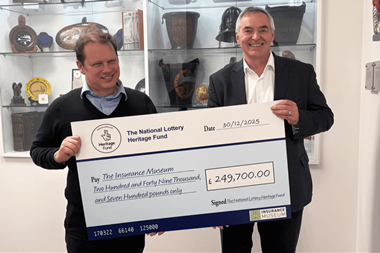Nazi Germany's horrific attempt to produce a master race seems a world apart from genetic research today. However, the Human Genome Project – an international venture to discover all 30,000-40,000 human genes – shares a common ancestry with the sinister use of eugenics. Completion of the project could bring enormous medical benefits, but it will also pose ethical dilemmas, both for individuals and for the insurance industry.
The study of genetics began in 1900 when several plant breeders discovered the work of the Austrian monk Gregor Mendel. In 1866 he had proposed laws of heredity based on cross-breeding experiments with pea plants. Scientists noticed that the patterns of inheritance described by Mendel mirrored the actions of chromosomes in dividing cells. They suggested that the chromosomes carried genes that determined inherited characteristics.
Researchers later found that each gene comprises strands of deoxyribonucleic acid (DNA), formed like a double helix, affecting heredity and enabling genetic information to be copied from cell to cell.
The first step
As every cell contains the entire genetic blueprint of the particular plant or animal, scientists realised that it was possible to produce identical organisms asexually from adult cells. In 1993, researchers at George Washington University caused outrage by cloning human embryos and nurturing them for several days in a Petri dish.
In 1997, Scotland's Roslin Institute cloned Dolly the sheep from the cell of an adult ewe.
Scientists have since cloned eight identical calves from cells taken from a single adult cow. Michael Crichton's 1990 novel Jurassic Park, where bio-engineered dinosaurs roam a palaeontological theme park, may be fiction, but technology is frighteningly close to making this scenario a reality.
The human genome is a person's complete collection of genetic material in the nucleus of every cell. By mapping this material, scientists will be able to associate specific human traits and inherited diseases with particular genes at precise locations on the chromosomes.
The Human Genome Project formally began in 1990, a public project with data shared by scientists around the world. However, the biotechnology industry soon recognised the enormous profits that the new genome business could bring. Various companies set out to identify and patent individual genes, investing $16bn (£11bn) in the first three months of 2000 alone.
To counter this, universities and government departments sped up the project and published their results to prevent patents being issued. They produced the working draft of the human genome in 2000 and expect to complete the entire project in 2003, two years ahead of plan.
The impact of genetic research is felt in many areas. The police now routinely use genetic fingerprinting in criminal investigations and have created a DNA database. Public concern over genetically modified foods is rarely out of the news. And DNA tests can accurately establish paternity and are increasingly being used in the US to prove adultery in divorce proceedings.
The use of human stem cells holds the prospect of miracle cures for diseases such as Parkinson's and Alzheimer's. But the technique is controversial as the cells are often harvested from artificially created embryos or from aborted foetuses. In Germany, all stem cell research is banned because of its associations with Nazi eugenics.
Doctors using in vitro fertilisation (IVF) techniques are now able to screen out embryos containing a genetic abnormality, something that currently leads to thousands of women suffering repeated miscarriages or giving birth to handicapped babies.
Another simple test enables doctors to screen embryos for low intelligence. However, critics fear this will lead to more abortions. They say that as low IQ is not life-threatening this is a significant step towards eugenics, echoing the scenario in Aldous Huxley's Brave New World, where certain babies were bred in hatcheries for menial tasks while others lived in luxury.
Design your baby
As technologies develop further, it will be possible not only to pre-screen babies for diseases and disabilities, but also to predetermine characteristics such as sex, skin, hair and eye colour, height and weight, intelligence and athletic abilities – creating so-called designer babies.
For insurers, the big issue is whether to use such genetic test results to assess applicants for life and health insurance. The Department of Health's Genetics and Insurance Committee (GAIC) recently announced that insurers could use the test for Huntington's disease – a genetically inherited fatal brain condition that affects about 5,000 people in the UK – to assess proposals for life insurance.
The GAIC is currently considering tests on six further diseases: Alzheimer's, familial adenomatous polyposis, myotonic dystrophy, multiple endocrine neoplasia, hereditary motor and sensory neuropathy and certain hereditary breast and ovarian cancers. All these diseases are thought to result from single gene disorders.
How far will it go?
Critics fear that tests for many other inherited diseases will follow. However, with most other disorders it is usually the interaction of genes, together with the effect of lifestyle and the environment, that determines whether a person will develop a particular disease.
Mary Francis, director general of the Association of British Insurers (ABI), stressed that the insurance industry recognised the legitimate social concerns and sensitivity surrounding genetic testing. She confirmed that insurers would never ask for a genetic test to be undertaken. However, applicants for life assurance (other than mortgage-related business up to £100,000) that have taken the test as part of their medical care now have an obligation to disclose the results.
Where the test is negative, the applicant will be eligible for cover at standard terms despite a family history of the condition. Where the test is positive, though, insurers may refuse cover or increase premiums. In reality, applicants are no worse off, as only people with a family history will have taken such a test and they should have declared this family history anyway. Furthermore, under the ABI's Genetic Testing Code of Practice, insurers must consider offering alternative terms where practicable, such as just excluding the particular disease.
The National Consumers' Council (NCC) has, however, condemned the government's decision to allow insurers to use the genetic test results. It fears the creation of an uninsurable genetic underclass and says that people could be dissuaded from taking tests that could be medically beneficial for them.
The NCC also argues that if the widespread use of genetic test results leads to a large sector of the population becoming uninsurable, then there has to be alternative insurance provision for them. The ABI has also acknowledged this and has stated that the insurance industry is willing to discuss alternative provision of cover, consistent with sound commercial practice.
Scientists at the Sanger Centre near Cambridge, who have sequenced a third of the human genome, fear that as Britain is one of the few countries to have approved the use of genetic tests for insurance purposes there will be a shortage of volunteers and this will force research abroad. It may also thwart plans by the government's medical research council to map the genes of Britain's population by taking DNA samples from 500,000 people with the eventual possibility of a national DNA database.
In addition to life assurance, the use of genetic tests is relevant also to income protection insurance (for long-term disability), critical illness, long-term care and private medical and travel insurance.
It's a question of trust
The Human Genetics Commission (HGC), an advisory committee set up in early 2000 to advise the government on developments in human genetics, points out that the DNA of the person who was analysed may reveal something about their relatives. Insurers have undertaken, however, not to take into account genetic test results declared by a blood relative when assessing a proposal for insurance.
A recent survey by the HGC shows that the vast majority of people believe that human genetic information should be used for understanding disease or identifying criminals, but that it should not be used for setting insurance premiums or for parents to choose the characteristics of their children. The survey reveals that insurance companies are among the least trusted groups – only 4% of respondents trust insurers to use information on databases responsibly. The HGC is now conducting a further major public consultation exercise with the results expected later this year.
Geneticists are tantalisingly close to understanding the blueprint of human life. Whether society uses this information responsibly remains to be seen.
Hosted by comedian and actor Tom Allen, 34 Gold, 23 Silver and 22 Bronze awards were handed out across an amazing 34 categories recognising brilliance and innovation right across the breadth of UK general insurance.













































